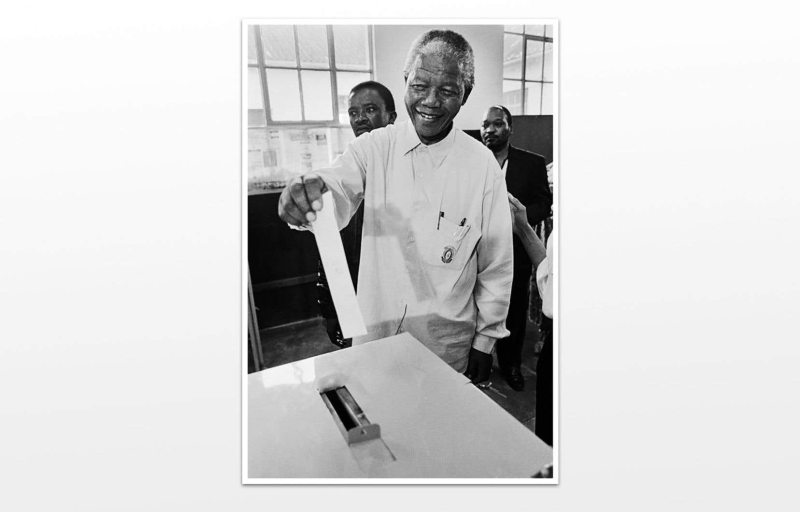
Photo: Wikimedia Commons Montage Le Devoir “South Africans remember this day as something sacred.”
Stephanie Marin
Published at 0:00 Updated at 12:49 a.m.
- Africa
At age 75, Nelson Mandela voted for the first time in his life, in South Africa's first multiracial election, a vote that brought him to power as his country's president. Thirty years later, to the day, two men remember for Le Devoirthis historic event while they were in the front row: one saw “Madiba” place his ballot in the ballot box, and the other, an anti-apartheid activist in forced exile, had returned to his native country to vote.
April 27, 1994 was the second of four days of presidential voting in South Africa, three years after the repeal of the racist and segregationist policies of apartheid — and only four years after the release of Congress leader Nelson Mandela African National Party (ANC).
That day, he chose a polling station far from his home.
He went to the one installed inside Ohlange Secondary School, not far from the city of Durban. The place was symbolic: it was the first school founded by a black person in the country, in 1901. And it was there that many black, mixed race and Indian South Africans voted for the first time decades later. It was also because the ANC feared that the province of KwaZulu-Natal would escape its control.
Workers were busy inside the polling station when suddenly they saw the future president enter. Applause and cries of joy immediately rang out, remembers David Gallagher, who worked for Oxfam-Canada. The Canadian NGO had set up a team of observers for the election.
Nelson Mandela, his hair white with age and 27 years in prison, was “very calm,” reports Mr. Gallagher. “He was very popular. He knew he was going to win. »
Also read
- 30 years ago, the election that changed South Africa
He saw him place his ballot in the ballot box, with “his characteristic smile”. Afterwards, he stood close to the box and opened his arms. Mr. Gallagher rose to the occasion. “I was the first to shake his hand and congratulate him,” the Oxfam worker recalls with pride. His face lit up and he said, “thank you.” »
Dressed in a cream-colored shirt-tunic, he re-created the scene shortly after in front of the school for photographers from the international press. “This is the beginning of a new era,” he said in a brief speech.
That day was “memorable,” said Mr. Gallagher, who had been working in Africa for years. Oxfam finally opened an office in Durban in 1991. Mr Gallagher says he was close to people in the ANC and well integrated into the anti-apartheid movement. He had received this precious fragment of information: Mandela would go to vote in Ohlange. So he arranged to be there, with his Oxfam-Canada colleague Meyer Brownstone. He was not going to miss the historic moment.
They were the only two international election observers allowed inside. Outside, Mr. Gallagher saw the long lines of people waiting: “Everyone was so happy to be able to vote, after everything they had been through with apartheid. » The polling stations remained open well after the scheduled hours, he added.
He voted alongside his parents
Some 1300 km away, in a suburb of Cape Town, Dan O'Meara also voted.
Like the others, he waited in line for nearly three hours, under the bright sun, to cast his ballot. “Blacks, whites, mixed race, people of all origins, all languages, everyone was talking to each other in the line. As if all racial barriers had fallen. »
“It was the most human moment in the history of the country,” said in an interview the political scientist born in South Africa and who now teaches relations international at UQAM.
He remembers putting his hook “next to the photo of Nelson Mandela’s face. »
“Aside from the day my daughter was born, it was the biggest day of my life. […] It was a blessing. A total liberation of the country. Even with the disappointment that followed, even if the elation did not last, South Africans remember the day as something sacred. »
He describes a jubilant crowd, even before the official election result was known: “In the street, people were singing and dancing. »
Specializing in African politics, the professor was an anti-apartheid activist and member of Nelson Mandela's party for 20 years, risky activities, marked by the assassination of around ten of his close friends . He had to go into exile after the South African government of the time stripped him of his citizenship due to his militant activities.
In an interview, he explained that 'he was ashamed of his country, his white community and the culture he was born into.
On April 27, 1994, he was able to put this shame aside .
“The idea that, ultimately, this exceptionally beautiful country is returning to the human community. We are turning our backs on a form of terrible Nazism, of monstrous crimes. It is a new beginning, made in a spirit of reconciliation and peace.”
He voted alongside his parents, a particularly moving moment for him: his father had volunteered at 18 to go fight Nazism in Europe. But afterwards, “he fell into a great depression because his own country fell into fascism. »
That day, “he was beside himself with joy,” he remembers, his voice breaking with emotion. Mr. O’Meara catches his breath: “As if his country was finally coming back to common sense. »

